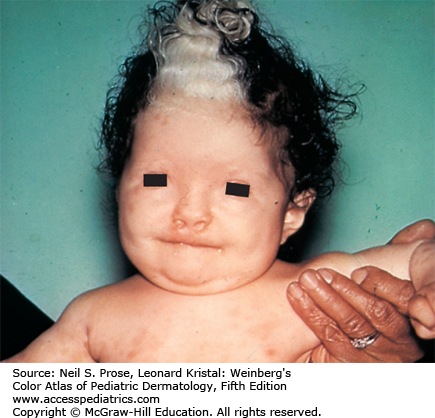Dermatology Question of the Week: Pediatric Problems

You are consulted to evaluate a newborn in the hospital nursery for the following hair abnormality.

Upon further investigation, you note that the iris of the right eye does not match that of the left eye. Which of the following is the patient at risk for? (hint: more than one may be correct)
A. No increased risk of other conditions
B. Bleeding diathesis
C. Reduced visual acuity
D. Deafness
E. Hirschsprung's disease
Rationale:
Correct answers: D. Deafness & E. Hirschsprung's disease
The combination of a white forelock shown above and the description of heterochromatic irides is consistent with a diagnosis of Waardenburg syndrome. Waardenburg syndrome is an autosomal dominant disorder resulting in the absence of melanocytes in certain areas of the skin, eyes, and cochlea. Other associated abnormalities include deafness, broad nasal root, and dystopia canthorum. There are several clinical variants of Waardenburg syndrome and type 4 is associated with Hirschsprung's disease.
Incorrect answers:
A. No increased risk of other conditions. Piebaldism is an autosomal dominant disorder presenting with a white forelock and depigmented areas of skin. It does not present with heterochromatic irides. Although it can be quite striking clinically, patients with piebaldism do not have any associated conditions.
B. Bleeding diathesis. Hermansky-Pulak syndrome is characterized by silvery hair (typically diffuse and similar to that seen in oculocutaneous albinism), bleeding diatheses (due to the absence of platelet dense bodies and platelet aggregation), as well as pulmonary fibrosis and granulomatous colitis later in life. This condition is autosomal recessive and more common in Puerto Ricans.
C. Reduced visual acuity. Patients with oculocutaneous albinism frequently have hypopigmented hair, fair skin, photophobia, and visual impairment. A variety of subtypes have been discovered with different genetic causes and phenotypes for each subtype.
Additional reading at Chapter 75: Albinism and Other Genetic Disorders of Pigmentation.

Create a Free MyAccess Profile
AccessMedicine Network is the place to keep up on new releases for the Access products, get short form didactic content, read up on practice impacting highlights, and watch video featuring authors of your favorite books in medicine. Create a MyAccess profile and follow our contributors to stay informed via email updates.